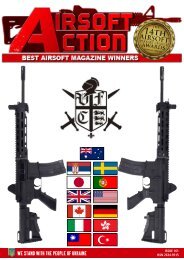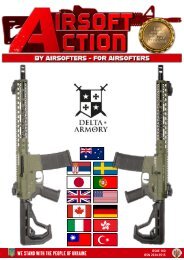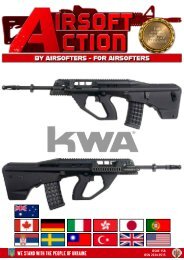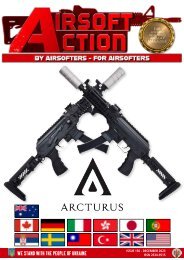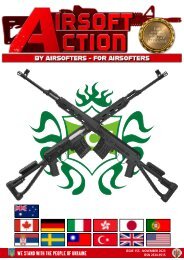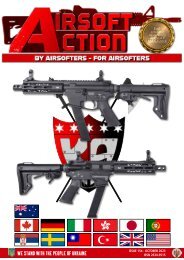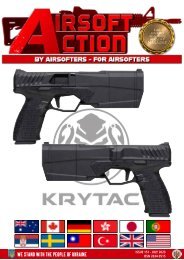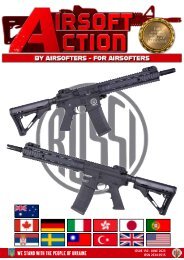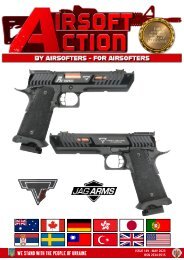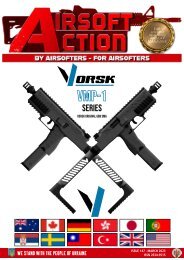PMCI - February 2017
Welcome to a whole new year of Private Military Contractor International. The team hit the ground running with this issue following a very successful visit to SHOT Show 2017 in Las Vegas which is reported fully. This issue also has an in depth interview with Dark Angel Medical and reviews of new knives and tools from SOG, an innovative lighting system for your AR and an overview of a revolutionary new training tool. If you’re working in the private military sector then PMCI is the magazine for you!
Welcome to a whole new year of Private Military Contractor International.
The team hit the ground running with this issue following a very successful visit to SHOT Show 2017 in Las Vegas which is reported fully.
This issue also has an in depth interview with Dark Angel Medical and reviews of new knives and tools from SOG, an innovative lighting system for your AR and an overview of a revolutionary new training tool.
If you’re working in the private military sector then PMCI is the magazine for you!
You also want an ePaper? Increase the reach of your titles
YUMPU automatically turns print PDFs into web optimized ePapers that Google loves.
pmcimagazine.com<br />
TAC GEAR - BATTLE BELTS<br />
• Fighting loads<br />
If you are going to use your battle belt in the field then you<br />
will probably want to customise your belt for your job. The<br />
addition of extra magazine pouches will be the first on your<br />
list. A minimum of two handgun magazines and a minimum<br />
of one rifle magazine should be carried on the battle belt, with<br />
maybe a utility pouch to carry extra ammunition and grenades<br />
and not forgetting food and water. Think of your battle belt as<br />
a survival kit; ammunition to carry on the fight and that little<br />
extra for when the fight is over, just don’t overdo it. Whatever<br />
you decide to take, the battle belt will free up space on your<br />
vest and help spread the weight load.<br />
• Mission specific<br />
This is usually ammo, ammo, ammo. Stack as much ammo on<br />
the belt as possible. This will free up copious amounts of room<br />
on your vest allowing you to add all those mission specific<br />
extras like NVG, Communication sets, GPS, Breaching tools etc.<br />
Consideration must be taken into account when placing items<br />
on the vest, making sure that they don’t hinder the function of<br />
the kit on the battle belt. I have found in the past that I have<br />
been unable to retrieve certain items from the belt because<br />
items stowed in my vest have prevented me from doing so.<br />
Plan the layout of your belt then throw all your kit on to see if<br />
it is compatible and works well with your vest and other kit.<br />
• Medical<br />
Personal First Aid Kits or PFAK are exactly what they mean, a first<br />
aid kit for you. PFAK’s are intended for personal use only and<br />
are not to be used for the treatment of others. On the one way<br />
range the RO should have access to a range first aid kit, on the<br />
two way range individuals should carry their own PFAK. If you<br />
use your PFAK on someone else and then something happens<br />
to you, your first responder may not have a medical kit to hand<br />
and all you can give them is an empty PFAK. There are plenty<br />
of commercial PFAK’s on the market to choose from, but you<br />
may want to ditch the contents and add your own. Dressings,<br />
FFD, Israeli dressing, sheers, tourniquet, and personal drugs are<br />
a good start. Of course you will need to know how to apply<br />
treatment, so a certification in first aid is needed. The PFAK<br />
should ideally be positioned in the middle of the belt at the<br />
back so it is out of the way but easily accessible by both hands.<br />
The contents need to be kept in a waterproof bag or container<br />
and stowed in the PFAK pouch. The PFAK pouch should also be<br />
clearly marked and should also include your blood type.<br />
ADDITIONS<br />
• Dump Pouch<br />
Dump pouches are nothing more than a bag to drop or dump<br />
your spent magazines or recovered intel/evidence into. Most<br />
dump pouches roll up out of the way when not being used.<br />
Dumping your spent magazines into a separate pouch ensures<br />
you don’t replace them in pouches alongside full magazines.<br />
Once empty the spent magazines are simply dumped into the<br />
bag and forgotten about until you need to recharge them. The<br />
top of the pouch usually has a stiffened neck to hold the mouth<br />
open for easily dumping the magazines. Since the magazines<br />
are empty and of no further use until recharged, both rifle and<br />
handgun magazines can be placed in the dump pouch together.<br />
It’s not essential for you to carry a dump pouch on your battle<br />
belt but it can make life a little easier when you need to make<br />
an emergency or combat reload when the situation gets a little<br />
hot. I spent many years throwing spent magazines down the<br />
inside of my jacket; this was known as a “Brecon Pouch”. That,<br />
however, was in the days when I didn’t wear ballistic protection.<br />
Now I wear a ballistic plate carrier of some description it’s near<br />
impossible to use the good old “Brecon Pouch”. I have found<br />
space for a dump pouch and I must say that it’s easy and quick<br />
to use. I’ve not included a dump pouch on my civilian belt as<br />
I don’t go through tonnes of ammunition and if I did, I would<br />
have the luxury of time to change magazines.<br />
• Ancillaries and Tools<br />
Apart from the basic and essential items to carry on your<br />
battle belt, there may be other tools you may want to consider<br />
adding. Multi-tools can be a god-send at times, especially if it<br />
is a weapons tool. A small knife won’t go amiss either. White<br />
light (flash light) can also be an asset. These extra items can<br />
be added to the battle belt and, if they don’t come with their<br />
own pouch, most small items will fit into handgun magazine<br />
retention pouches. The use of a small to medium utility or<br />
GP (general purpose) pouch is often a help. Items such as<br />
notebook and pencil, snap-caps, weapons cleaning kit etc can<br />
be placed in here. You can even use one as a caddy to collect<br />
spent brass off the range. Personally I use mine to carry my ear<br />
defenders in. Battle belts can be customised to suit any need<br />
just remember not to overload them with things<br />
you don’t want or need. Keep it simple.<br />
NOTE:<br />
Belts supplied by<br />
www.nicks-kit.co.uk<br />
28<br />
pmcimagazine.com




